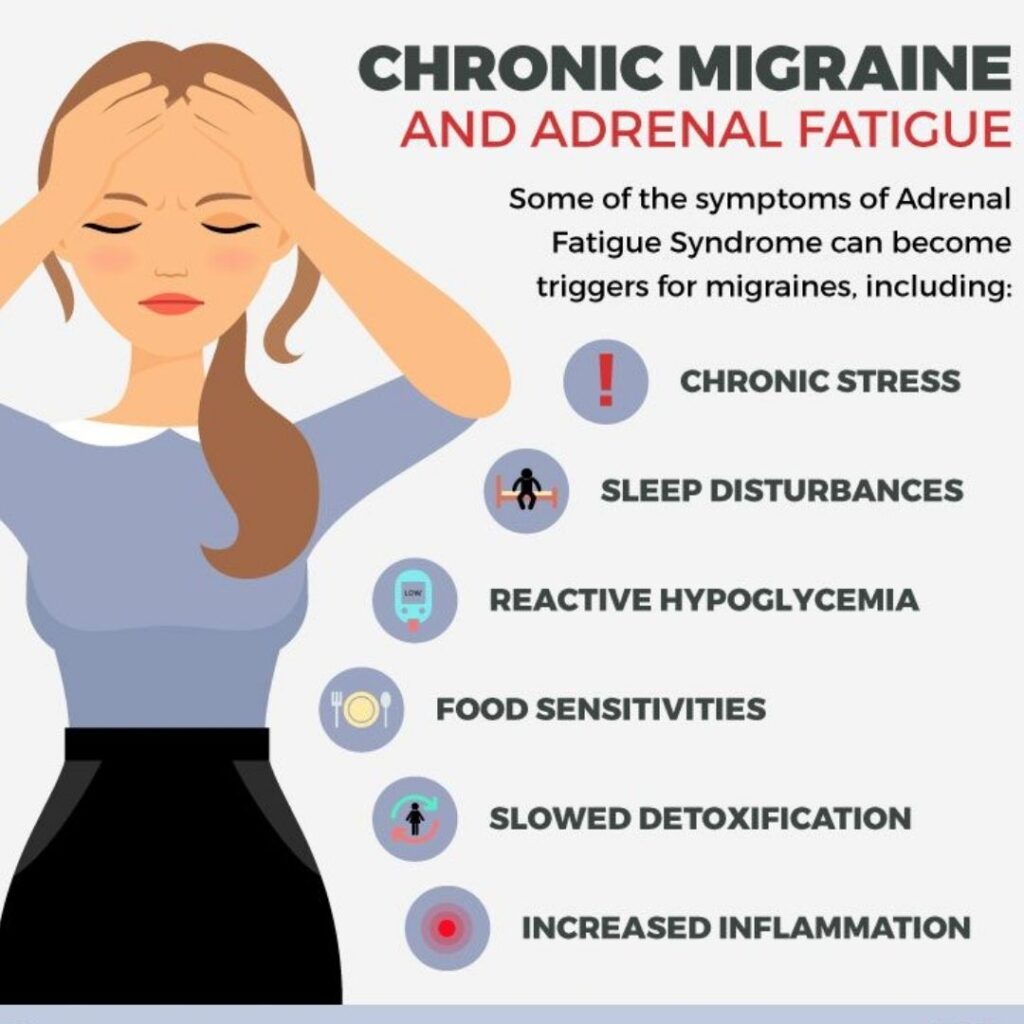What is chronic migraine?

Chronic migraine is a neurological condition characterized by the presence of migraine headaches on at least 15 days per month for at least three months, with at least eight of those headaches being migraines. Migraine headaches are typically characterized by a throbbing pain on one side of the head, often accompanied by nausea, sensitivity to light and sound, and visual disturbances.
Chronic migraine is a complex condition that can have a significant impact on a person’s quality of life, and may require long-term treatment and management. Some possible causes of chronic migraine include genetics, hormonal imbalances, environmental factors, and lifestyle factors such as stress, lack of sleep, and poor diet. Treatment may involve a combination of medication, lifestyle changes, and behavioral therapies to manage symptoms and prevent future migraines.
Who gets chronic migraine?
Chronic migraine can affect anyone, but it is more commonly found in individuals who have a history of episodic migraines (migraines that occur less frequently) or a family history of migraines. Women are also more likely than men to develop chronic migraine.
Other risk factors for chronic migraine include:
- Age: Chronic migraine often begins in early adulthood, but can develop at any age.
- Medication overuse: Overuse of pain-relieving medications, including those used to treat migraines, can actually trigger chronic migraines.
- Other medical conditions: Chronic migraine may occur alongside other medical conditions, such as depression, anxiety, fibromyalgia, or chronic pain disorders.
- Lifestyle factors: Certain lifestyle factors, such as poor diet, lack of sleep, stress, and physical inactivity, can increase the risk of chronic migraine.
Overall, the exact causes and risk factors for chronic migraine are still being researched and are not fully understood.
What causes chronic migraine?
The exact causes of chronic migraine are not fully understood, but researchers believe that a combination of genetic, environmental, and lifestyle factors may play a role.
Some possible factors that may contribute to chronic migraine include:
- Genetics: Studies have shown that migraines tend to run in families, indicating a genetic component to the condition.
- Brain chemistry: Research has suggested that changes in certain chemicals in the brain, such as serotonin and dopamine, may contribute to the development of migraines.
- Hormonal changes: Fluctuations in hormones, particularly estrogen, can trigger migraines in some people. This may explain why women are more likely than men to experience migraines.
- Environmental triggers: Certain environmental factors, such as bright lights, loud noises, strong odors, and changes in weather or barometric pressure, can trigger migraines in some people.
- Medication overuse: Overuse of pain-relieving medications, including those used to treat migraines, can actually trigger chronic migraines.
- Lifestyle factors: Certain lifestyle factors, such as poor diet, lack of sleep, stress, and physical inactivity, can increase the risk of chronic migraine.
It’s important to note that chronic migraine is a complex condition that can have multiple causes, and the specific triggers and contributing factors can vary from person to person.
What are the symptoms of chronic migraine?
The symptoms of chronic migraine are similar to those of regular migraines, but occur more frequently. Chronic migraine is defined as having headaches on at least 15 days per month for at least three months, with at least eight of those headaches being migraines.
The symptoms of chronic migraine can include:
- Headache pain that is typically throbbing or pulsing and may occur on one or both sides of the head
- Sensitivity to light, sound, or smells
- Nausea or vomiting
- Blurred vision or other visual disturbances, such as seeing flashing lights or zigzag lines
- Lightheadedness or dizziness
- Fatigue or feeling tired
- Difficulty concentrating or thinking clearly
- Mood changes, such as feeling irritable or depressed
The severity and duration of chronic migraine symptoms can vary from person to person, and may be affected by factors such as stress, diet, and other lifestyle factors. If you experience frequent headaches or migraines, it’s important to speak with a healthcare provider to determine the cause and develop an appropriate treatment plan.
How is chronic migraine diagnosed?
Diagnosing chronic migraine typically involves a combination of a thorough medical history, physical exam, and other tests to rule out other potential causes of headaches.
During a medical history, a healthcare provider will ask about the frequency and severity of headaches, as well as any associated symptoms such as nausea, sensitivity to light or sound, or visual disturbances. They may also ask about any family history of migraines or other neurological conditions.
A physical exam may also be conducted to check for any underlying medical conditions that could be contributing to headaches or migraines.
In some cases, imaging tests such as a CT scan or MRI may be ordered to rule out other potential causes of headaches, such as a brain tumor or aneurysm.
Based on the results of these evaluations, a healthcare provider may diagnose chronic migraine if the person has experienced headaches on at least 15 days per month for at least three months, with at least eight of those headaches being migraines.
It’s important to note that chronic migraine can be a complex condition with multiple contributing factors, and a healthcare provider may also consider lifestyle factors such as stress, diet, and sleep habits when developing a treatment plan.
How is chronic migraine treated?
Treatment for chronic migraine typically involves a combination of medication, lifestyle changes, and behavioral therapies aimed at managing symptoms and preventing future migraines.
Medications commonly used to treat chronic migraine include:
- Preventive medications: These medications are taken regularly to prevent migraines from occurring. They may include beta blockers, antidepressants, antiepileptic drugs, and Botox injections.
- Acute medications: These medications are taken at the onset of a migraine to relieve symptoms. They may include over-the-counter pain relievers such as acetaminophen, ibuprofen, or aspirin, or prescription medications such as triptans or ergotamines.
Lifestyle changes that may help manage chronic migraine include:
- Maintaining a regular sleep schedule
- Eating a healthy diet and staying hydrated
- Regular exercise
- Stress management techniques such as relaxation therapy or meditation
- Avoiding triggers such as bright lights, loud noises, or certain foods
Behavioral therapies such as cognitive-behavioral therapy or biofeedback may also be helpful in managing chronic migraine by teaching individuals how to better cope with stress and pain.
It’s important to work closely with a healthcare provider to develop a comprehensive treatment plan that is tailored to the individual’s specific needs and symptoms.
Can chronic migraine be prevented?
While there is no guaranteed way to prevent chronic migraine, there are several steps that can be taken to reduce the frequency and severity of migraines:
- Identify and avoid triggers: Certain factors can trigger migraines, such as stress, certain foods, lack of sleep, and hormonal changes. Identifying and avoiding these triggers can help prevent migraines.
- Maintain a regular sleep schedule: Getting enough sleep and maintaining a regular sleep schedule can help prevent migraines.
- Eat a healthy diet: Eating a healthy diet that includes plenty of fruits, vegetables, whole grains, and lean proteins, while avoiding trigger foods, can help prevent migraines.
- Stay hydrated: Dehydration can trigger migraines, so it’s important to drink plenty of water throughout the day.
- Exercise regularly: Regular exercise can help reduce stress and improve overall health, both of which can help prevent migraines.
- Manage stress: Stress is a common trigger for migraines, so it’s important to find healthy ways to manage stress, such as practicing relaxation techniques or engaging in regular exercise.
- Take medication as prescribed: If a healthcare provider has prescribed medication to prevent migraines, it’s important to take it as directed to help prevent migraines from occurring.
It’s important to note that what works for one person may not work for another, and that preventing chronic migraine often involves a combination of lifestyle changes, medication, and other therapies. Working closely with a healthcare provider can help develop an individualized plan to prevent and manage chronic migraine
What’s the outlook for people with chronic migraine?
The outlook for people with chronic migraine can vary depending on the severity of their condition and how well it responds to treatment.
With proper treatment and management, many people with chronic migraine are able to reduce the frequency and severity of their headaches, allowing them to better manage their symptoms and improve their quality of life.
However, chronic migraine can be a challenging condition to manage, and some individuals may continue to experience frequent headaches despite treatment. In some cases, chronic migraine can lead to disability and a decreased ability to work or participate in daily activities.
It’s important for individuals with chronic migraine to work closely with their healthcare provider to develop an effective treatment plan and to make necessary lifestyle changes to manage their symptoms. By taking a proactive approach to managing their condition, many people with chronic migraine are able to successfully manage their symptoms and improve their overall quality of life.




